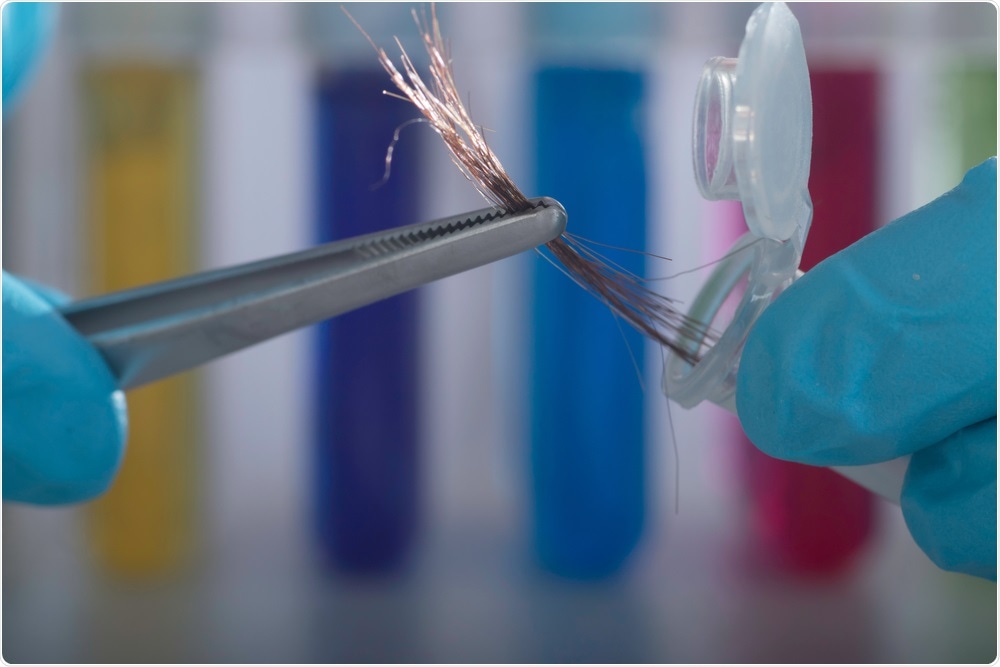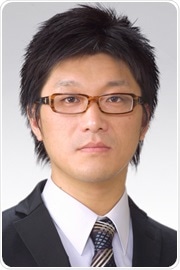In this interview, AZoLifeSciences speaks to Dr. Shinsuke Kunimura about his latest research which involved combining Raman spectroscopy and X-ray fluorescence to identify an individual from a single strand of hair.
What provoked your research into forensic science and, in particular, hair analysis?
My research group has been researching the development of analytical techniques for highly sensitive analysis of chemical substances using portable instruments that can be used for on-site analysis. Chemical information obtained from various types of samples left at a crime scene can be a clue in determining whether a suspect is involved in the crime, and highly sensitive on-site analytical techniques make it possible to rapidly acquire such information.
Therefore, my research group began to investigate the possibility of the application of analytical techniques using portable instruments to forensic science.

Hair sample found at a crime scene. Image Credit: Tonhom1009/Shutterstock.com
Why is hair found at a crime scene an important piece of evidence? Why is important to be able to accurately identify the source of the hair?
Because hair usually falls out without noticing, there is a possibility that single hairs from the criminal are left at a crime scene. Various types of information such as color, elemental composition, DNA sequence, and morphology from a single hair found at a crime scene will help to determine whether this hair originates from a suspect, and methods to distinguish the difference among single hairs from multiple people are needed to identify whose hair is whose.
The accurate determination of whether a hair sample collected at a crime scene is attributed to a suspect can help to determine whether a suspect is involved in the crime. On-site analytical techniques for obtaining information that is beneficial for individual identification from a single hair can contribute in rapidly identifying whose hair it is. Therefore, my research group aimed at the establishment of a method for the identification of hairs using chemical information obtained with portable instruments.
There are many people with dyed hairs, and a method to obtain chemical information about a hair dye product used for hair coloring from a single hair sample can also help to identify whose hair it is. Recently, a method to distinguish hair dyes on single dyed hair samples using surface-enhanced Raman scattering (SERS) spectroscopy has already been reported by Kurouski et al. (D. Kurouski and R. P. Van Duyne, Anal. Chem., 2015, 87, 2901).
On the other hand, in 2018, my research group started research on a highly accurate method to distinguish the difference among single dyed hairs using a combination of SERS and X-ray fluorescence (XRF) analyses.
What are some of the current problems faced by DNA analysis using hair samples?
Highly accurate individual identification can be performed using short tandem repeat (STR) analysis of nuclear DNA. However, a hair root sheath is needed to adhere to hair to perform STR analysis of nuclear DNA. A hair root sheath is not always adhered to a single fallen hair found at a crime scene. When a single hair that does not have a hair root sheath is collected at a crime scene, other methods will be needed to be applied to the identification of hairs.
Therefore, it is desirable that methods to obtain either biological or chemical information from a single hair sample, which can play a key role in individual identification when STR analysis of DNA cannot be performed, are established.
Can you describe how you carried out your latest research into hair analysis?
I have researched about development and improvement of a portable total reflection X-ray fluorescence (TXRF) spectrometer for trace elemental analysis (S. Kunimura and J. Kawai, Analyst, 2010, 135, 1909)” since 2006 when I was a doctoral course student at Kyoto University. My research group applied this portable spectrometer to the elemental analysis of single hair samples. On the other hand, all members of my research group have never performed SERS measurements before starting our research about hair analysis.
To determine the procedure for almost non-destructive SERS measurements of single hair samples, we mainly referred to a paper about fiber analysis using SERS spectroscopy (C. Zaffino, H. T. Ngo, J. Register, S. Bruni, and T. Vo-Dinh, Appl. Phys. A, 2016, 122, 707).
What did you discover?
My research group showed that single hairs colored with different hair dye products can be distinguished by a combination of SERS and XRF analyses using portable spectrometers.
What role did surface-enhanced Raman spectroscopy (SERS) and X-ray fluorescence (XRF) play in your research?
SERS analysis is beneficial for obtaining information about organic substances, and SERS spectral patters of single dyed hairs tend to be different according to hair dye products used for hair coloring. Therefore, single dyed hairs can be distinguished by the difference among SERS spectral patterns. However, SERS spectral patters of single hairs dyed by different hair dye products that contain or produce similar types of hair dyes tend to be similar. In this case, single dyed hairs cannot be distinguished by SERS spectroscopy.
By using XRF analysis, elements originating from ingredients or impurities contained in hair dye products used for hair coloring can be detected. If the types of elements detected from different single dyed hairs whose SERS spectral patterns are similar are different, these single hairs can be distinguished. Therefore, XRF analysis can play a supporting role in the identification of hairs using SERS analysis.

Portable Raman Spectrometer. Image Credit: Forance/Shutterstock.com
What were the benefits of using SERS and XRF compared to other analytical techniques available?
XRF analysis can be used for non-destructive elemental analysis of a single hair. SERS analysis of a single hair can also be performed without sample destruction although there is a possibility that silver (or gold) nanoparticles used for the measurement attach to the hair sample. Therefore, almost non-destructive identification of single dyed hairs can be performed using a combination of SERS and XRF analyses.
SERS and XRF analyses can be performed with the use of portable spectrometers, and using portable spectrometers makes it possible to perform an on-site analysis of single hairs. Therefore, this combination can contribute to the rapid identification of hairs.
Do you believe that this method will enable investigators to quickly identify hair samples found at a crime scene?
My research group showed that a combination of SERS and XRF analyses using portable spectrometers was beneficial for distinguishing the difference among single hairs colored with different hair dye products. Therefore, I believe that this combination contributes to rapidly obtaining the information for individual identification from a single hair found at a crime scene.

Dyed Hair. Image Credit: Subbotina Anna/Shutterstock.com
Do you believe that your research will also help to show other researchers how analytical tools that are commonly used within chemistry can also be adapted to work in a variety of fields including forensic science?
My research group shows that a combination of SERS and XRF analyses can be applied to forensic investigation. I hope that our research becomes an opportunity to expand the application fields of various analytical methods.
What are the next steps in your research?
A combination of XRF and SERS analyses is beneficial for distinguishing the difference among single dyed hairs. However, it will be difficult to distinguish undyed hairs using this combination. Therefore, we are going to research the development of a method to distinguish undyed hairs using several analytical methods.
About Dr Shinsuke Kunimura
Dr. Shinsuke Kunimura is an Associate Professor at the Faculty of Engineering, Tokyo University of Science, Japan. In 2004, he graduated from the Faculty of Engineering at Kyoto University in Japan. He became a JSPS (The Japan Society for the Promotion of Science) Research Fellow in 2008, and then he obtained his Ph.D. in Engineering from Kyoto University in 2009.
Then, he has researched at Riken (The Institute of Physical and Chemical Research) as a Special Postdoctoral Researcher for two years (2010-2012). He became a Junior Associate Professor at Tokyo University of Science in 2012, and he has been an Associate Professor at the same university since 2018.